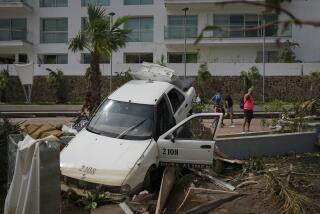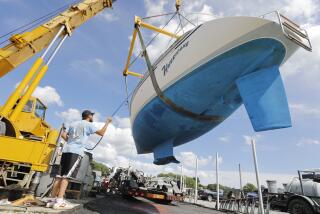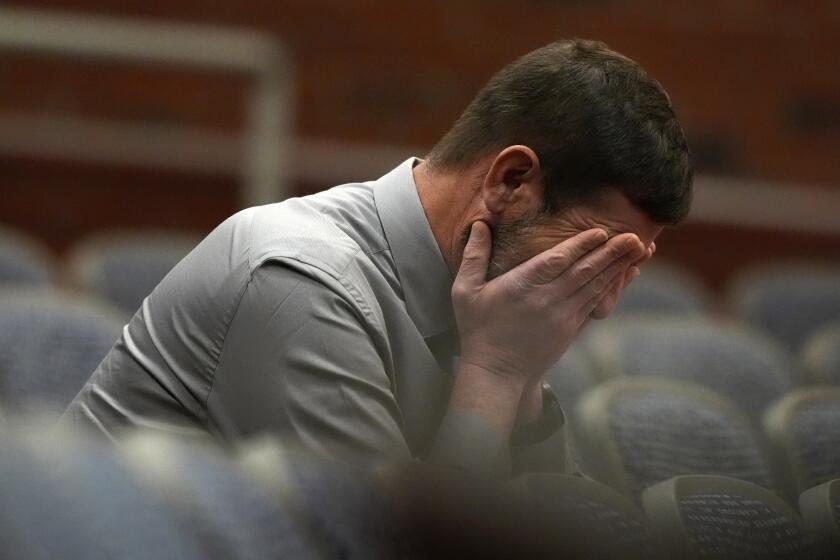Coastal residents from Florida to Louisiana flee Ivan
Frightened residents of the Gulf Coast from Florida’s Panhandle to Louisiana’s bayous boarded up windows, packed up and hit the road today to flee from Hurricane Ivan.
A hurricane watch was posted for a 420-mile-long swath from St. Marks in the Florida Panhandle, just south of Tallahassee, to New Orleans and Morgan City, La.
At 2 a.m. today, Ivan was centered about 265 miles south-southeast of the mouth of the Mississippi River and moving north-northwest at 12 mph.
Authorities ordered or strongly urged residents and tourists to evacuate coastal areas of the Florida Panhandle, Alabama, Mississippi and Louisiana. Schools were closed in New Orleans and parts of Florida, Mississippi and Alabama, and some areas started opening shelters. Panama City Beach was deserted at dawn today.
“This is a serious storm that requires serious action to get people out of harm’s way,” Alabama Gov. Bob Riley said.
Ivan, a killer blamed for at least 68 deaths in the Caribbean, is a Category 4 hurricane with top sustained wind at 140 mph, down from 160 mph -- Category 5 strength -- earlier.
“That’s a monster they’ve got out there. I’m not taking any chances,” Irvin Bruce said as he and his wife, Lillian, packed to leave the Copa Casino in Gulfport, Miss., to return to their home west of New Orleans. If necessary, he said, they would keep going west.
Although they’re on the western side of the watch area, New Orleans and its suburb of Jefferson Parish urged their population of around 1 million to head for higher ground, and suburban St. Charles Parish ordered its 49,000 residents to leave.
New Orleans is flanked by the Mississippi River and broad Lake Pontchartrain, and needs a system of canals and huge pumps to keep it dry because parts of it are as much as 10 feet below sea level. The city hasn’t taken a major direct hit from a hurricane since Betsy in 1965, which flooded some neighborhoods up to 7 feet deep. Many highways leading out of the metro area are prone to flooding, severely limiting escape routes.
The spot where the center of the storm would make landfall was anyone’s guess, but New Orleans Mayor Ray Nagin noted that hurricane-strength wind -- at least 75 mph -- was possible as far as 100 miles out from Ivan’s center. He declared a state of emergency for the city.
“We don’t know if were going to get a punch in the mouth or a kick in the knee. But we’re going to get hit,” Jefferson Parish President Aaron Broussard said at a news conference.
Forecasters warned that Ivan still could strengthen before hitting shore. They also said it could slow down or stall over the Appalachians this weekend, raising the risk of serious flooding.
Oil and gas rigs in the Gulf of Mexico had been evacuated and hundreds of people abandoned fishing settlements on Mexico’s Yucatan peninsula, and the storm’s threat also affected oil producers on shore.
“We started to shut down refineries. We now know that there is going to be a crude oil production shutdown and a product output shutdown,” Jan Stuart, head of energy research at FIMAT USA, a brokerage unit of Societe Generale, told The Associated Press.
The Coast Guard had not restricted traffic on the lower Mississippi River below New Orleans but shipping companies voluntarily stopped operations late Monday and early today and ordered their vessels tied down.
“The vessel traffic is basically nonexistent,” Petty Officer Nyx Cangemi said today.
Residents south of Interstate 10 in Mississippi’s coastal counties were ordered to evacuate, and the state’s Gaming Commission ordered the 12 Gulf Coast casinos to close today.
Panhandle residents needed no more reminders of the perils of powerful hurricanes. Hurricanes Charley and Frances caused billions in damage and were blamed for more than 50 deaths statewide; Ivan could make landfall as the triumvirate’s most powerful.
President Bush asked Congress for an additional $3.1 billion today to help Florida and other states recover from their recent batterings. That comes on top of $2 billion approved last week but does not extend to Ivan.
The Mississippi National Guard had been placed on active duty.
All over low-lying southern Louisiana, residents made plans to leave.
Even storm-hardened residents of the Louisiana barrier island town of Grand Isle seemed more worried than usual, said Wanda Kirby, owner of the Sandpiper Motel.
“People who have never left before are packing up and leaving town. Everyone has their car loaded,” said Kirby, who said her family was leaving immediately, a routine precaution for them.
Hotels across western and northern parts of Louisiana were filling up with people seeking higher ground. “It is a bittersweet situation when your best business is during a disaster,” Mike Radiky, general manager of the Lafayette Holiday Inn Central Holidome.
Most schools and colleges along the Panhandle closed. Military installations were sending at least 275 aircraft well away from Ivan’s possible path.
------
Associated Press Writers Bill Kazcor in Pensacola Beach, Fla.; Hilary Roxe in Key Largo, Fla.; Eugenio Diosdado in Cancun, Mexico; Vanessa Arrington in Pinar Del Rio, Cuba; Shelia Hardwell Byrd in Biloxi, Miss.; Bob Johnson in Montgomery, Ala.; and Janet McConnaughey in New Orleans contributed to this report.
More to Read
Start your day right
Sign up for Essential California for news, features and recommendations from the L.A. Times and beyond in your inbox six days a week.
You may occasionally receive promotional content from the Los Angeles Times.






